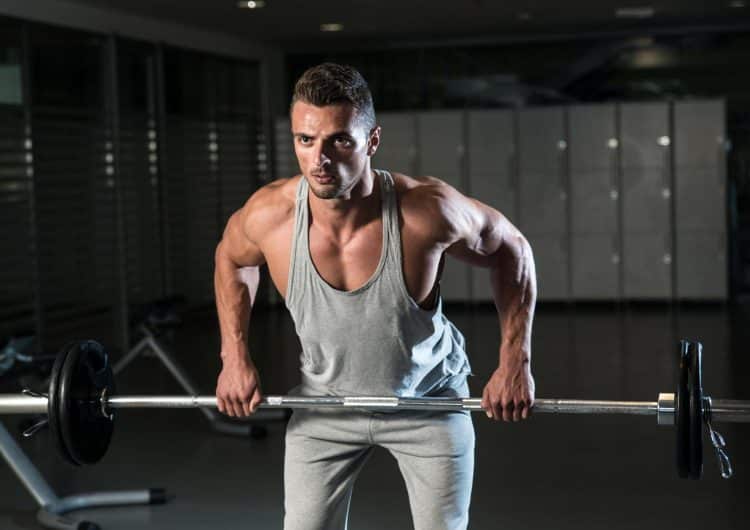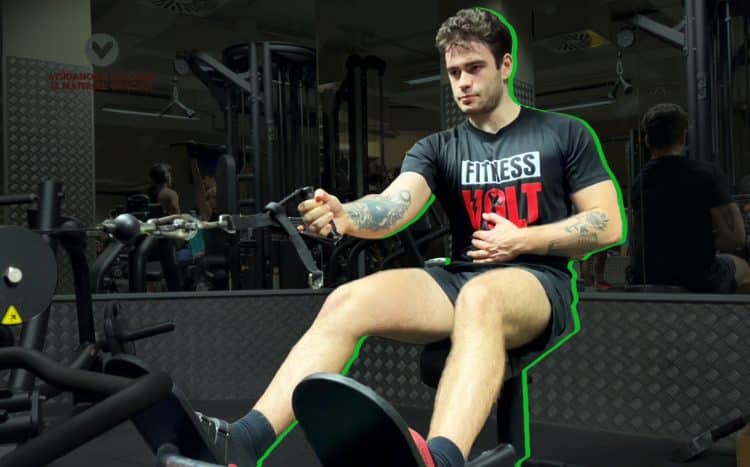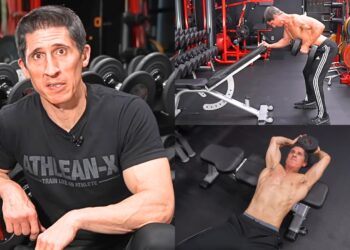Whether you’re a bodybuilder, tennis player, or a hobbyist gym-goer, rowing is probably an exercise you’ve done at least once.
A comparative study published in Frontiers in Biomedical Engineering and Biotechnology found that rowing machine exercises improved muscle strength, endurance, and motor coordination. (1)
However, if you didn’t feel the muscle stimulation instantly, your technique might be incorrect, or you could have picked the wrong weight. When performed correctly, the effectiveness of this exercise on your back muscles is very much noticeable.
When I first started training almost a decade ago, I often felt that I overused my biceps while rowing and didn’t engage my back muscles optimally. This changed when I started experimenting with different grips.
In this guide, I will introduce you to different row grips, explain their roles, and discuss common mistakes to avoid.
Understanding Row Grips
Level Up Your Fitness: Join our 💪 strong community in Fitness Volt Newsletter. Get daily inspiration, expert-backed workouts, nutrition tips, the latest in strength sports, and the support you need to reach your goals. Subscribe for free!
How often do you pick up the weights without thinking about the grip?
For many exercisers, grip is a mere formality, which is a colossal mistake; every seasoned bodybuilder will confirm that.
The lats, rhomboids, biceps, and forearms all come into play with movements like the conventional bent-over row or the seated cable row. Your grip determines which muscle will be primarily targeted.
Before we move on, remember that the choice between an overhand, underhand, or any other grip is not a question of right or wrong. It’s a strategic move, and it’s up to you (or your personal trainer) to choose the one that fits the best into your training regimen.
Types of Row Grips and Their Applications
Here is the difference between hand positions and grips:
Hand position
Underhand, overhand, mix, neutral, and hook – do we have a winner? Let’s find out.
Overhand
The overhand grip involves holding a barbell, dumbbell, or kettlebell with your palms facing down.
When you grasp the bar or handles with an overhand grip during rowing exercises, the primary beneficiaries are the upper back muscles, notably the latissimus dorsi, trapezius, and rhomboids. The downside is a significant strain on the forearms, which can limit training volume.
Underhand
Conversely, the underhand grip, with palms facing up, shifts the focus to the biceps and the upper back. For many, including myself, this is a more comfortable grip because it emphasizes forearm flexors more than extensors, and flexors are stronger (2). However, you may struggle to focus on the back muscles instead of the biceps with an underhand grip.
Mixed
A mixed grip involves holding a bar with one hand in an overhand and the other in an underhand position. Many bodybuilders use this grip, particularly for heavy deadlifts.
Personally, I’m not a fan of mixed grip; I don’t find it comfortable. However, that doesn’t mean you shouldn’t try it when doing rowing exercises.
Neutral
The neutral grip, where palms face each other, is ideal when using dumbbells. This grip minimizes stress on the wrists and shoulders while targeting the upper-back muscles. It is an excellent option for those with joint concerns or if you want a middle ground between the overhand and underhand positions.
Hook/Suicide
Hook and suicide are variations of the previous grips. The hook is very popular in weightlifting and powerlifting. It involves placing the thumb parallel to the bar and securing it with the fingers. This grip enhances forearm engagement.
On the other hand, the suicide grip, also known as the false grip, involves placing the thumb on the same side of the bar as the fingers. The name suicide grip suggests the potential risks, but it is not dangerous for rowing.
Width
While there are numerous ways to grip a barbell, ultimately, it boils down to the three primary types — narrow, standard, and wide.
Moderate
A moderate grip is best for beginners and for engaging the back muscles evenly. That grip is slightly wider than shoulder-width and does not strain any muscle group excessively.
Wide
Placing your hands wider than shoulder-width apart (often over twice the shoulder width) emphasizes the outer portions of the back, specifically the lats and the rear delts. I do not recommend it to beginners because it is taxing on the shoulders.
Narrow
A narrow grip biases the upper back by bringing the hands closer together (closer than shoulder-width).
I prefer a V-bar handle on a rowing machine for targeting muscles using this grip, but you should try both and find what suits you better.
Level Up Your Fitness: Join our 💪 strong community in Fitness Volt Newsletter. Get daily inspiration, expert-backed workouts, nutrition tips, the latest in strength sports, and the support you need to reach your goals. Subscribe for free!
Right Grips For Your Training Goals
An exercise isn’t limited to a single goal, like building strength or boosting endurance. By adjusting factors like the weight, cadence, reps, or the number of sets, you can tailor any exercise to meet your specific objectives.
The same applies to grips. One grip is not inherently better for strength than another and vice versa. Nevertheless, I wanted to give you a few tips and help you choose the best grips in relation to your training goals.
For Strength
Selecting the appropriate rowing grip is crucial when your primary goal is to build strength.
The reason is obvious — you need full control over the weights to hit a PB. In most cases, overhand grips are the best for weightlifting. I believe that width is actually essential. Go with a shoulder-width grip if you primarily want to build strength.
For Muscle Growth and Definition
If you focus more on aesthetics, diversity in rowing grips is your ally. Incorporate a combination of wide and narrow grips to target different areas of your back.
Also, don’t shy away from experimenting with underhand and overhand grips to stimulate varied muscle fibers.
Common Mistakes To Avoid
The following grip mistakes can sabotage your workout:
- Grabbing the bar too tightly — Clinging onto the bar with a death grip might seem useful for holding onto heavier weights, but it often leads to unnecessary tension in the forearms. It can limit your endurance during prolonged sets. Try to achieve a firm yet relaxed grip. The key is finding the sweet spot where you maintain control without overexerting your forearms.
- Failure to adjust grip for different exercises — Understand the unique demands of each rowing exercise and adjust your grip accordingly. For example, an overhand grip may be ideal for bent-over rows to target the upper back, while an underhand grip could better engage the lower lats during seated cable rows.
- Ignoring grip fatigue warning signs — Pushing through a workout despite signs of grip fatigue is a common oversight. Consequently, other muscle groups may compensate, leading to improper form and potential injury. If you find your fingers slipping or your grip weakening mid-set, consider adjusting your grip, reducing weight, or giving your hands a brief rest.
- Skipping hand and forearm warm-ups — Prioritize hand and forearm warm-ups as part of your pre-workout routine. Simple exercises like wrist circles, finger stretches, and squeezing a stress ball can help increase blood flow to these areas, preparing them for the upcoming demands.
How To Perform a Barbell Bent-Over Row
Understanding the various grips is crucial, but it’s more important to master the correct technique. Even the best grip choice cannot compensate for poor execution.
I decided to go with the barbell bent-over row out of all the variations because it is a compound exercise with an unparalleled ability to target and sculpt the back muscles. It is a staple in most strength training routines.
How To:
- Stand with feet hip-width apart, knees slightly bent.
- Grip the barbell with hands slightly wider than shoulder-width apart.
- Maintain a straight back as you hinge at the hips, lowering the barbell towards the floor.
- Your torso should be at 45 degrees.
- Pull the barbell towards your lower chest, squeezing the shoulder blades together.
- Slowly lower the barbell back to the starting position.
Pro Tip: Think about your elbows throughout the motion. Keep them tight to your sides and pull them behind the midline. That way, you will emphasize your lats even better.
Row Exercise Variations
Rowing exercises have several variations. These exercises primarily target your back, but your arms will be engaged, too. However, the degree of specific muscle activation and recruitment will vary depending on the rowing exercise, grip, technique, etc. For instance, seated cable rows will place less strain on your triceps than dumbbell rows.
Here are some of the most popular rowing exercises, each allowing you to take advantage of several grips:
Cable row
The cable row is a versatile exercise that can be performed both sitting and standing. The key to maximizing the benefits of cable rows lies in using different attachments. Experiment with wide grip bars, narrow grip handles, ropes, and V-bars to target every area of the back.
Pendlay row
As a compound movement, the Pendlay row is a powerhouse for upper back development. Since this movement allows you to lift significantly heavy, perfecting your form is crucial to prevent injuries and ensure optimal muscle activation.
Dumbbell row
I love dumbbell rows because of their versatility. You can do this exercise with one or two dumbbells, helping you address muscle imbalances and trunk strength (3). You can do it standing and on a weight bench. Change bench angles to target specific areas of the back.
Benefits of the Bent-Over Row
Still wondering if you should include the bent-over row in your regular workout? After you know the benefits, you will realize it is a no-brainer.
- Muscle Engagement — Most lifters want a V-taper, and rowing is one of the best exercises to achieve that. It primarily targets the lats, traps, and rhomboids. The biceps and other back muscles are also recruited.
- Strength Building — Row is a compound exercise excellent for building strength. You can significantly improve strength and power if you do it at least once a week. Try doing rows explosively if building power is your primary goal.
- Versatility — Regardless of your fitness level, rows should be a part of your workout regimen. Rowing exercises allow you to effortlessly adjust the poundage and target most upper back muscles. Adjust the load to match your current level and goal. You can also reduce the number of exercises needed to stimulate the back muscles, making your workout more time-efficient.
- Functional Strength — Rowing is a functional exercise that can improve your performance in daily activities and sports.
Read also: How to Build a V-Taper – Training Guide and Nutrition Tips
FAQs
How important is grip strength in rowing exercises?
Grip strength is essential for rowing exercises. A strong grip is necessary for holding heavy weights for the duration of the set, thus improving muscle engagement in each row. If you neglect grip strength, your workout will suffer.
Can using the wrong row grip lead to injuries?
Yes, using the wrong row grip can increase injury risk. The most common injuries resulting from the wrong row grip are hand and forearm strains, sprains, and overuse injuries.
What are the signs that my grip may be hindering my progress?
Persistent discomfort or pain in your hands, wrists, or forearms are signs that you should pay attention to. Additionally, if you constantly can’t maintain a firm hold on the barbell, it’s time to improve your grip technique and strength.
Wrapping Up
Every detail matters in the fitness world. And row grip is more than just a detail. It can often be the difference between highly effective and average training and the best injury prevention or cause.
Over time, you will develop a mind-muscle connection that helps you choose the best grip for each row variation. But even then, remember to change the grip occasionally to stimulate muscles differently.
So, as you grasp the bar for your next rowing session, do so with intention. Make each repetition count!
References
- Kang SR, Yu CH, Han KS, Kwon TK. Comparative analysis of basal physical fitness and muscle function in relation to muscle balance pattern using rowing machines. Biomed Mater Eng. 2014;24(6):2425-35. doi: 10.3233/BME-141056. PMID: 25226943.
- Hägg GM, Milerad E. Forearm extensor and flexor muscle exertion during simulated gripping work — an electromyographic study. Clin Biomech (Bristol, Avon). 1997 Jan;12(1):39-43. doi: 10.1016/s0268-0033(96)00049-6. PMID: 11415670.
- Saeterbakken A, Andersen V, Brudeseth A, Lund H, Fimland MS. The Effect of Performing Bi- and Unilateral Row Exercises on Core Muscle Activation. Int J Sports Med. 2015 Nov;36(11):900-5. doi: 10.1055/s-0034-1398646. Epub 2015 Jul 2. PMID: 26134664.
- Andersen V, Fimland MS, Wiik E, Skoglund A, Saeterbakken AH. Effects of grip width on muscle strength and activation in the lat pull-down. J Strength Cond Res. 2014 Apr;28(4):1135-42. doi: 10.1097/JSC.0000000000000232. PMID: 24662157.










